LET THERE BE LIGHT!

Above, from left to right:
- Fenix TK30 White Laser, LEP, Beam Distance 1200 metres, 500 lumens, 250€
- Noctigon KR4, 4 x SST-20 4000K, 95 CRI, 3000 lumens, 55$
- Ultrafire Infrared Flashlight, 5W IR LED, 20€
- KDLitker E6, orange, light blue, white 3000K, 25€
- Fenix LR35R, 10000 Lumens, 200€
- Convoy S2+, purple, orange, green, 25€
- Emisar D18, 18 x SST-20, 4000K, 95 CRI, 10000 Lumen, 109$
Below:
- Ryus Lightworks Light Painters Flashlight, 115€
- Fenix PD36R, 1600 Lumen, 100€
- Emisar D4V2, 4 x SST-20, 3000K, 95 CRI, 45$
- Lumintop Tool AA Titan, 650 Lumen, Nichia 219CT, 4000K, 70€ (Aluminium 25€)
- Convoy S2+, Osram UV-Led, 40€
- Noctigon DM11, SST-20, 4000K, 95 CRI, 1200 Lumen, 60$ (Sale next 50 days 40€)
BRIGHTNESS
Many manufacturers of torches, especially the not so good ones, like to write the highest possible luminous flux specifications on the packaging or in the flowery descriptions on the website. Ultimately, the lumen rating is not very meaningful. On the one hand, the intensity of the light that reaches the illuminated spot depends on the angle of radiation. The Fenix TK30 with its meagre 500 lumens illuminates parts several hundred metres away very brightly. The beam angle of this torch is only a few degrees. This means that the light cone is very narrow. The opposite of this is the Emisar D18 with a very homogeneous light cone that is approx. 80° wide. The range is about 50 metres. But the illuminated area is very large.
Whether the brightness stated by the manufacturer is achieved in reality (if it is true at all) depends first of all on the battery. The small D4V2 is powered by an 18650 battery. The four SST-20s have a total electrical output of 40 watts. In addition, there is the power loss of the driver. In total, the battery has to supply about 45 watts. This results in a current of 12 amps (45 watts / 3.7 volts). Most 18650 batteries cannot deliver this current permanently. Therefore, the maximum possible luminous flux is not reached. When buying batteries, it is therefore important to ensure that they can supply the necessary continuous current. The maximum pulse current is often specified. Even if this is stated as 20 or 30 amps, this does not mean that the battery can permanently deliver the continuous current required in the example above.
The brightness of most torches is regulated depending on the temperature in order to protect the electronics of the driver, the LED and the battery from overheating. The maximum brightness is therefore not permanently available with most torches. How quickly and how far the brightness is reduced depends on several factors. First of all, the quality and efficiency of the driver. The more heat loss it produces, the faster the torch is turned down. The second aspect is the thermal conductivity of the housing. A small housing made of titanium or stainless steel conducts heat much less effectively than a large housing made of copper or brass. I find it much more important how stable the second brightest level runs. With most good torches, this runs for 20 minutes or more without the brightness decreasing significantly. For light painting work, this is an important aspect.
Viele Hersteller von Taschenlampen, gerade die nicht so guten, schreiben gerne möglichst hohe Angaben zum Lichtstrom auf die Verpackung oder in die blumigen Beschreibungen auf der Internetseite. Letztendlich ist die Lumen Angabe nicht sehr aussagekräftig. Zum einen ist die Intensität des Lichts, welches an der beleuchteten Stelle ankommt abhängig vom Abstrahlwinkel. Die Fenix TK30 mit den mageren 500 Lumen beleuchtet Teile in mehreren hundert Meter Entfernung sehr hell. Der Abstahlwinkel dieser Taschenlampe beträgt nur wenige Grad. Somit ist der Lichtkegel sehr eng. Das Gegenteil dazu ist die Emisar D18 mit einem ca. 80° breiten, sehr homogen Lichtkegel. Die Reichweite liegt bei ungefähr 50 Metern. Dafür ist der beleuchtete Bereich sehr groß.
Ob die vom Hersteller angegebene Helligkeit in der Realität erreicht wird (wenn sie denn überhaupt stimmt) hängt ersteinmal vom Akku ab. Die kleine D4V2 wird mit einem 18650 Akku betrieben. Die vier SST-20 haben eine elektrische Leistung von insgesamt 40 Watt. Dazu kommt dann noch die Verlustleistung des Treibers. Insgesamt muss der Akku als eine Leistung von ungefähr 45 Watt versorgen. Somit ergibt sich ein Strom von 12 Ampere (45 Watt / 3,7 Volt). Die meisten 18650 Akkus können diesen Strom nicht dauerhaft abgeben. Somit wird der maximal mögliche Lichtstrom nicht erreicht. Beim Kauf der Akkus gilt es also darauf zu achten, dass diese den nötigen Dauerstrom liefern können. Oft wird der maximale Pulsestrom angegeben. Auch wenn dieser mit 20 oder 30 Ampere angegeben wird, bedeutet das noch lange nicht, dass der Akku dauerhaft die aus dem Beispiel oben benötigten Dauerstrom abgeben kann.
Die Helligkeit wird bei den meisten Taschenlampen abhängig von der Temperatur geregelt um die Elektronik des Treibers, die LED und den Akku vor Überhitzung zu schützen. Die maximale Helligkeit steht also bei den meisten Taschenlampen nicht dauerhaft zur Verfügung. Wie schnell und wie weit runtergeregelt wird hängt von mehreren Faktoren ab. Zuerst einmal von der Qualität und der Effizienz des Treibers. Umso mehr Verlustwärme dieser produziert, desto schneller wird die Taschenlampe runtergergelt. Der zweite Aspekt ist die Wärmeleitfähigkeit des Gehäuses. Ein kleines Gehäuse aus Titan oder Edelstahl leitet die Wärme viel schlechter ab als ein großes Gehäuse aus Kupfer oder Messing. Viel wichtiger finde ich, wie stabil die zweithellste Stufe läuft. Bei den meisten guten Taschenlampen läuft dieser über 20 Minuten oder länger ohne, dass die Helligkeit signifikant abnimmt. Für die Arbeit im Lightpainting ist das ein wichtiger Aspekt.

It took over 17 minutes to illuminate the huge hangar. If the brightness of the Emisar D18 had decreased significantly during this time, the work would have been much harder or the result worse.
Die Ausleuchtung des riesengroßen Hangars hat über 17 Minuten gedauert. Hätte die Helligkeit der Emisar D18 während dieser Zeit signifikant abgenommen wäre die Arbeit ungleich schwerer, oder das Ergebnis schlechter gewesen.

COLOUR TEMPERATURE UND COLOUR RENDERING INDEX (CRI)

I lit the rusty Dutchman in complete darkness with the 3000K Emisar D4V2. The torch's colour rendering index is 95. For comparison: candlelight has a CRI of 100, sodium vapour lamps (street lamps) have a CRI of 35 to 40 and the ugly Led Lenser torches usually have a CRI of no more than 70. This value describes how well and how vividly colours are rendered when illuminated with the torch. The colour temperature also has an influence on the result. Cold white light with 6000K or above is usually very unattractive. Neutral white (4000K) or warm white (3000K or lower) are perceived as much more pleasant by the human eye. When buying a new torch, one should always pay attention to the colour temperature and also the CRI. In most cases, manufacturers specify the former, but unfortunately often not the CRI. However, if the CRI is above 90, this is a purchase argument for many people. For this reason, the manufacturer will advertise the torch with the high CRI. If this information is missing, the CRI will probably be quite low.
Den rostigen Holländer habe ich in völliger Dunkelheit mit der 3000K Emisar D4V2 beleuchtet. Der Farbwiedergabindex der Taschenlampe liegt bei 95. Zum Vergleich: Kerzenlicht hat einen CRI von 100, Natriumdampflampen (Straßenlaternen) haben einen CRI von 35 bis 40 und die häßlichen Led Lenser Taschenlampen haben einen CRI von meist nicht über 70. Dieser Wert beschreibt wie gut und wie kräftig Farben wiedergegeben werden wenn sie mit der Taschenlampe beleuchtet werden. Auch die Farbtemperatur hat Einfluss auf das Ergebnis. Kaltweißes Licht mit 6000K oder darüber ist meist sehr unansehnlich. Neutrales Weiß (4000K) oder warmes Weiß (3000K oder kleiner) werden vom menschlichen Auge als viel angenehmer wahrgenommen. Beim Kauf der neuen Taschenlampe sollte man immer auf die Farbtemperatur und auch den CRI achten. Erstere geben die Hersteller in den meisten Fällen an, den CRI leider oftmals nicht. Wenn der CRI allerdings über 90 liegt, ist das für viele Leute ein Kaufargument. Aus diesem Grund wird der Hersteller mit dem hohen CRI die Taschenlampe bewerben. Wenn die Angabe fehlt wird der CRI wohl recht gering sein.

SIZE, WEIGHT, MATERIAL

Most torches are made of aluminium alloys. Aluminium is a passable heat conductor, inexpensive and quite easy to machine. Torches made of titanium alloys are much more robust than specimens made of aluminium or copper. You can probably drive over the small Lumintop (middle torch in the picture) 38 times in a crowded bus without damaging the torch. Titanium, however, has two very decisive disadvantages. Titanium is a poor conductor of heat. For this reason, the area of the housing where the driver sits is made of brass. Besides, the stuff is very expensive. The small Lumintop costs three times as much in the titanium version as the same torch made of aluminium.
In principle, it is of course very pleasant if the torch is as small and light as possible, but only to the point that the function is not restricted. The lighter the material, the faster the torch reduces its brightness. In addition, the runtime of the small Tool AA with the small 14500 battery is of course significantly shorter than that of a torch with the same LED and a large 18650 battery.
Die meisten Taschenlampen werden aus Aluminiumlegierungen gefertigt. Aluminium ist ein passabler Wärmeleiter, preisgünstig und lässt sich recht einfach bearbeiten. Taschenlampen aus Titanlegierungen sind wesentlich robuster als Exemplare aus Aluminium oder Kupfer. Über die kleine Lumintop (mittlere Taschenlampe im Bild) kann man wahrscheinlich 38 Mal mit dem vollbesetzten Omnibus fahren, ohne dass die Taschenlampe Schaden nimmt. Titan hat allerdings zwei ganz entscheidende Nachteile. Titan ist ein schlechter Wärmeleiter. Aus diesem Grund ist der Bereich des Gehäuses, in dem der Treiber sitzt, aus Messing. Außerdem ist das Zeug sehr teuer. Die kleine Lumintop kostet in der Titan Variante das dreifache der gleichen Taschenlampe aus Aluminium.
Grundsätzlich ist es natürlich sehr angenehm wenn die Taschenlampe möglichst kleine und leicht ist, allerdings nur bis zu dem Punkt, dass die Funktion nicht eingeschränkt wird. Umso wenigier Material, desto schneller regelt die Taschenlampe die Helligkeit herunter. Darüber hinaus ist natürlich die Laufzeit der kleinen Tool AA mit dem kleinen 14500 Akku deutlich kürzer als bei einer Taschenlampe mit gleicher LED und großem 18650 Akku.

BEAM

The picture shows two Emisar D4V2s. On the left with floody optics, on the right with clear optics. Both torches are flooders, i.e. they illuminate a large area very evenly. The matt "floody optic" intensifies this effect.
Im Bild sind zwei Emisar D4V2 zu sehen. Links mit "floody optics", rechts mit klarer Optik. Beide Taschenlampen sind Flooder, beleuchten also eine großen Bereich sehr gleichmäßig. Durch die matte "floody optic" wird dieser Effekt noch verstärkt.
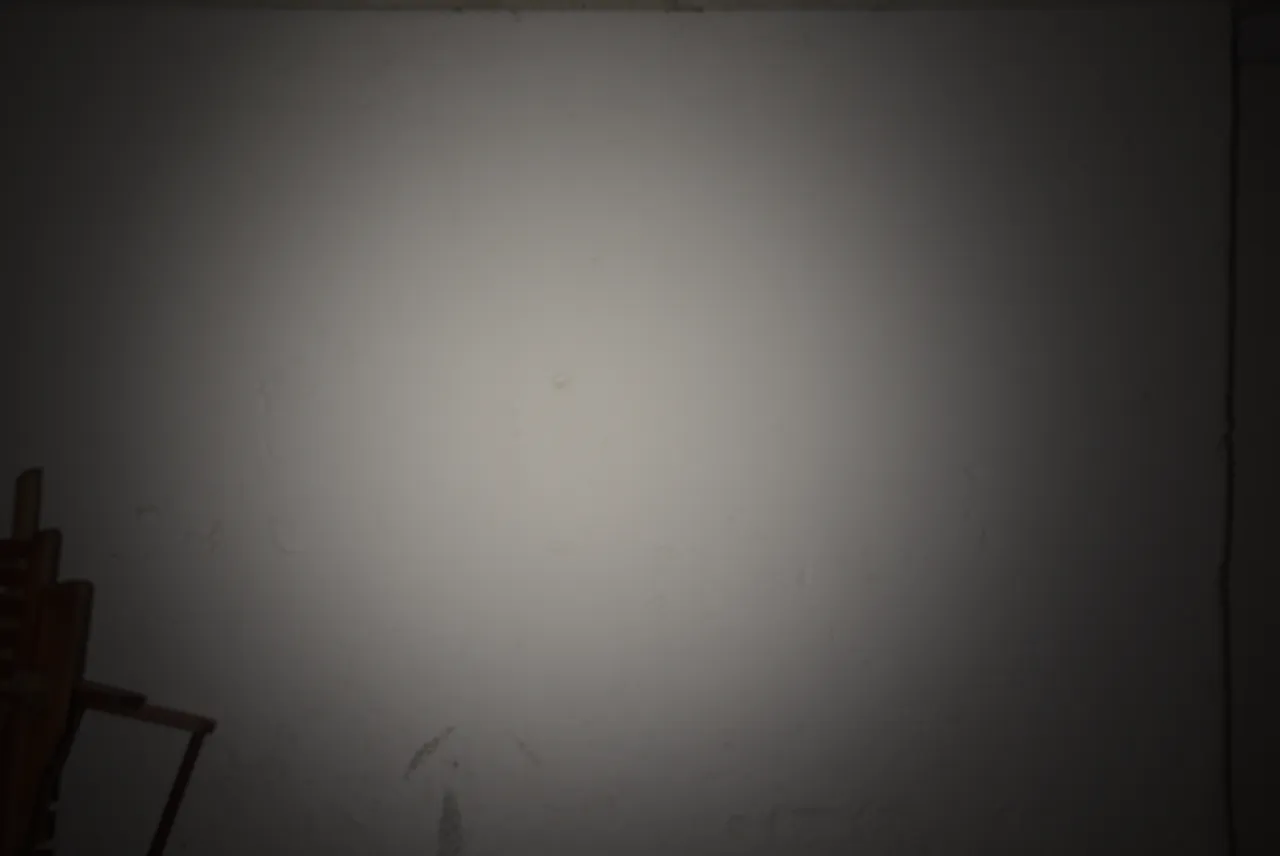
Emisar D4V2, 4000K, floody optic
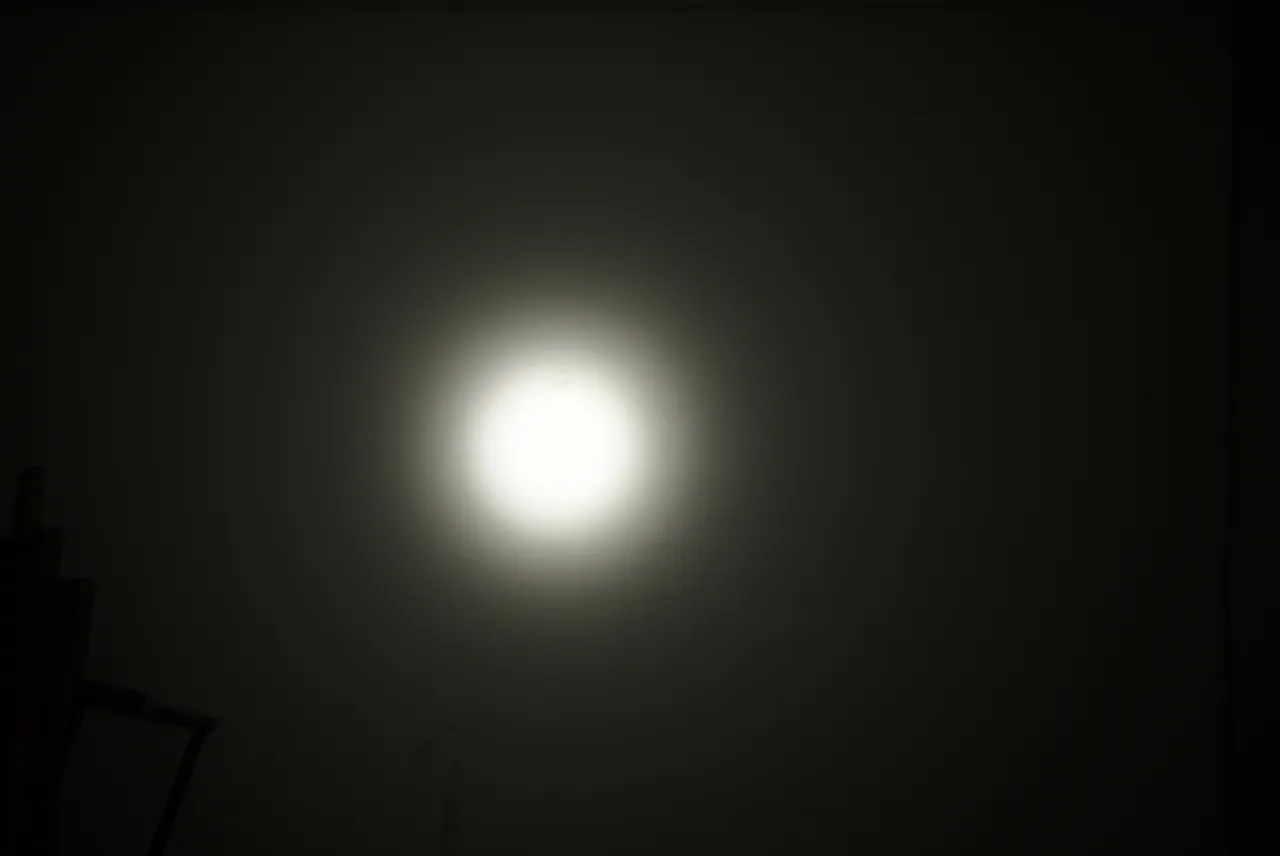
Noctigon DM11, 4000K
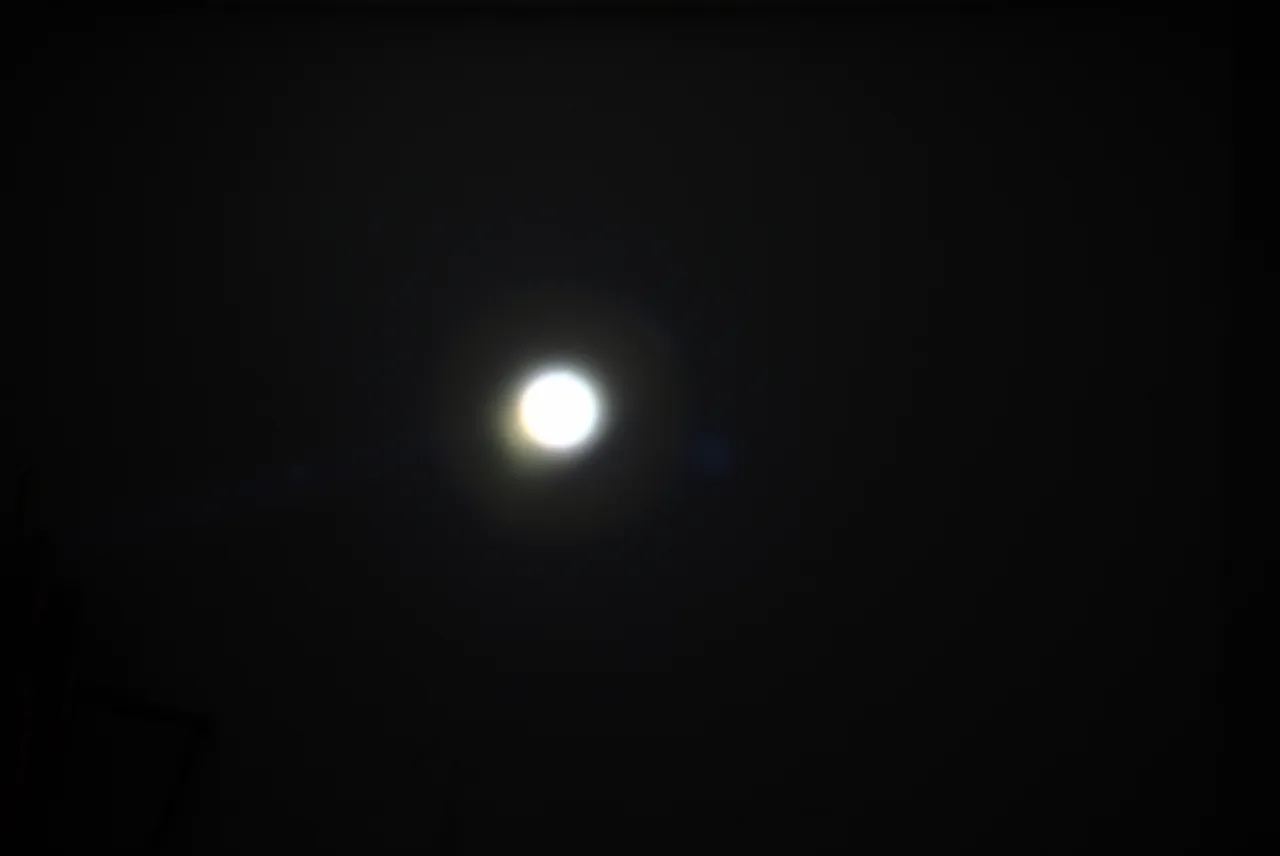
Fenix TK30, LEP
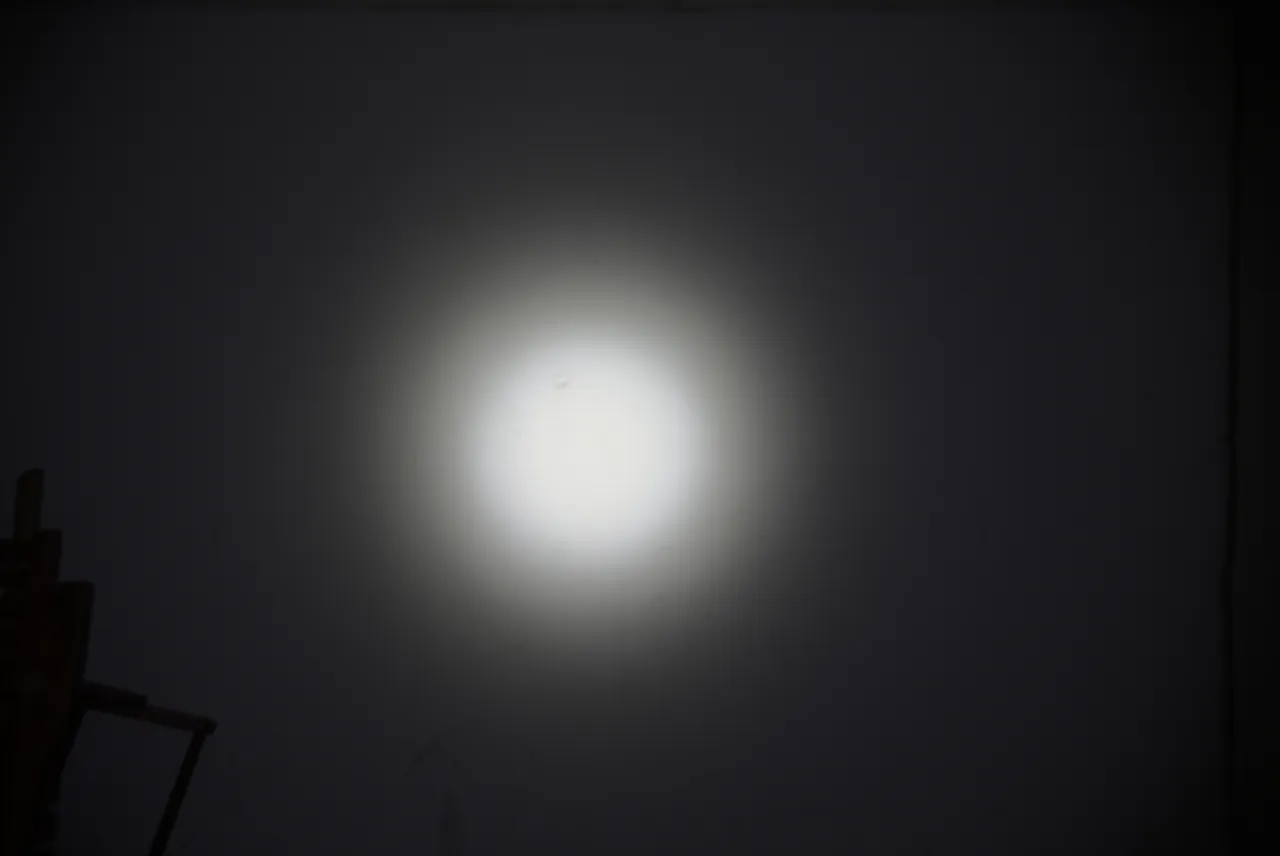
Fenix PD36R
The differences are clearly visible in the beamshots. The distance between the torches and the cellar wall was the same in all shots (approx. 4 metres). The Emisar illuminates a larger area than the camera shows. Unfortunately, my cellar is not larger. The small Noctigon DM11 thrower only illuminates a very small area and therefore a very large range. This effect is even more pronounced with the TK30. However, this is not a normal torch. A phosphor layer is stimulated to glow with a blue laser. This light is then directed forward with mirrors and lenses, bundled and emitted from the head of the torch. LEP torches are currently not available in the European Union. Fortunately, I bought mine a few years ago. The last beamshot shows a classic EDC torch. It illuminates a small spot in the middle very brightly and a larger area around with low brightness. For normal use, this is quite useful. In the dark forest I can see what is coming at me at a distance of 30 to 40 metres and at the same time I don't fall on my face because the area in front of my feet is still brightly enough illuminated. However, EDC torches are less suitable for illuminating light painting. I would always prefer a classic flooder. And then there are torches with zoom. No one needs such a thing any more. Led Lenser is pretty much the only manufacturer of such torches. All these torches emit a very ugly light. The LEDs have a colour temperature of 6500K - 7000K and a very low CRI. Furthermore, the Led Lenser torches are very expensive. At the latest with the permanently installed special batteries and these strange magnetic charging parts, I am completely out. So stay away from Led Lenser, no matter how many important light painters tell you that you absolutely need them for light painting.
In den Beamshots sind die Unterschiede gut zu sehen. Der Abstand der Taschenlampen zur Kellerwand war bei allen Aufnahmen gleich (ca. 4 Meter). Die Emisar beleuchtet einen größeren Bereich, als von der Kamera dargestellt wird. Leider ist mein Keller nicht größer. Der kleine Thrower Noctigon DM11 beleuchtet nur ein sehr kleinen Bereich und dadurch eine sehr große Reichweite. Noch deutlich fällt dieser Effekt bei der TK30 aus. Das ist allerdings keine normale Taschenlampe. Mit einem blauen Laser wird eine Phosphorschicht zum leuchten angeregt. Dieses Licht wird dann mit Spiegeln und Linsen nach vorne gerichtet, gebündelt und aus dem Kopf der Taschenlampe emittiert. LEP Taschenlampen sind aktuell nicht in der Europäischen Union erhältlich. Zum Glück habe ich meine schon vor einigen Jahren gekauft. Im letzten Beamshot ist eine klassische EDC Taschenlampe zu sehen. Diese beleuchtet einen kleinen Spot in der Mitte sehr hell und einen größeren Bereich herum mit geringer Helligkeit. Für den normalen Einsatz ist das recht sinnvoll. Im dunklen Wald kann ich sehen was in 30 bis 40 Metern in Entfernung auf mich zu kommt und gleichzeitig stürze ich nicht auf die Fresse weil der Bereich vor meinen Füßen noch hell genug beleuchtet wird. Zur Ausleuchtung im Lightpainting sind EDC Taschenlampen allerdings eher weniger geeignet. Da würde ich immer einen klassischen Flooder vorziehen. Und dann gibt es noch Taschenlampen mit Zoom. So etwas braucht mittlerweile kein Mensch mehr. Die Firma Led Lenser ist mittlerweils so ziemlich der einzige Hersteller solcher Taschenlampen. Alle diese Taschenlampen emittieren ein sehr hässliches Licht. Die LEDs haben eine Farbtemperatur von 6500K - 7000K und einen sehr geringen CRI. Darüber hinaus sind die Led Lenser Taschenlampen sehr teuer. Spätestens bei den fest verbauten Spezialakkus und diesen merkwürdigen Magnetladeteilen bin ich komplett raus. Also Finger weg von Led Lenser, egal wie viele wichtige Lightpainter erzählen, dass man die unbedingt zum Lightpainting braucht.

USER INTERFACE
In the meantime, there are the craziest user interfaces. Stepless brightness adjustment (ramping), several strobe modes, candlelight, thunderstorms and other funny things. The torch from Light Painting Paradise is particularly worth mentioning here. @ryuslightworks has programmed a very special UI that exactly meets the needs of the light painter. Ten brightness levels, several different strobe modes with changeable frequency in the previously selected brightness, momentary mode and single flash mode. And each mode can be saved and is thus available immediately after switching on. It doesn't get any better than this. The Anduril UI can also change the brightness and frequency of the strobe modes, but the mode is not saved. Direct use is only possible in Momentary Mode.
Most Muggle torches have three to five brightness levels and strobe. This is quite sufficient for normal use. Even for torches that I use to illuminate the light painting scene, a few (sensible) brightness levels are sufficient if they are saved.
Mittlerweile gibt es ja die verrücktesten User Intefaces. Stufenlose Helligkeitseinstellung (Ramping), mehrere Strobe Modes, Kerzenlicht, Gewitter und noch andere lustige Sachen. Besonders erwähnenswert ist hier die Taschenlampe von Light Painting Paradise. @ryuslightworks hat eine ganz besondere UI programmiert, die genau die Bedürfnisse des Lightpainters erfüllt. Zehn Helligkeitsstufen, mehrere verschiedene Strobe Modes mit veränderbarer Frequenz in der zuvor gewählten Helligkeit, Momentary Mode und Einzelblitzmodus. Und jeder Mode kann gespeichert werden und steht somit direkt nach dem Einschalten zur Verfügung. Besser geht es nicht. Die Anduril UI kann zwar auch Helligkeit und Frequenz der Strobe Modes verändern, aber der Mode wird nicht gespeichert. Eine direkte Verwendung ist nur im Momentary Mode möglich.
Die meisten Muggel Taschenlampen verfügen über drei bis fünf Helligkeitsstufen und Strobe. Für den normalen Einsatz genügt das völlig. Auch für Taschenlampen, die ich zur Ausleuchtung der Lightpainting Szene verwende, genügen einige (sinnvolle) Helligkeitsstufen, wenn diese gespeichert werden.

BATTERIES AND CHARGING

You should only use rechargeable batteries from reputable manufacturers. The current should match the torch, as already mentioned above. The capacity is certainly also a purchase argument, but the battery with the highest available capacity is not necessarily the best choice. Often these cells can only deliver a very low current or the capacity drops massively when the discharge current increases.
Man sollte nur Akkus von namhaften Herstellern verwenden. Der Strom sollte zur Taschenlampe passen, wie bereits oben erwähnt. Die Kapazität ist sicher auch ein Kaufargument, allerdings ist der Akku mit der höchsten erhältlichen Kapazität nicht unbedingt die beste Wahl. Oft können diese Zellen nur einen recht geringen Strom abgeben oder die Kapazität sinkt massiv wenn der Entladestrom steigt.

The easiest way is if the torch has a USB charging port. You don't need a charger and you don't have to take the battery out of the torch. Some batteries have a charging port. This also saves the charger, but the battery is then a little longer and no longer fits in all torches.
Die einfachste Möglichkeit ist es, wenn die Taschenlampe über ein USB Ladeport verfügt. Man braucht kein Ladegerät und muss den Akku nicht aus der Taschenlampe nehmen. Einige Akkus verfügen über einen Ladeport. Das erspart zwar ebenfalls das Ladegerät, allerdings ist der Akku dann etwas länger und passt nicht mehr in alle Taschenlampen.

There are universal chargers, such as the XSTAR VC4. Lithium batteries of various sizes and NiMH batteries can be charged in this charger, even simultaneously. The charging characteristic is reasonable, the batteries are charged quickly without unnecessarily shortening the life of the batteries.
Es gibt Universalladegeräte, wie das XSTAR VC4. In diesem lassen sich sowohl Lithium Akkus verschiedener Größen sowie NiMH Akkus laden, auch gleichzeitig. Die Ladekennlinie ist vernünftig, die Akkus werden schnell geladen ohne die Lebensdauer der Akkus unnötig zu verkürzen.

RECOMMENDATIONS

I'll keep it short:
- small EDC torch - Lumintop Tool AA (14500, AA NiMH or AA battery).
- classic EDC torch - Convoy S2+ (18650 battery) or Fenix PD36R (21700 battery incl. charging port in the torch)
- Torch for painting light trails - Lightpainters torch from Light Painting Paradise
- Torch for illumination - Emisar D18 (SST-20 with 3000 or 4000K High CRI LEDs) or Fenix LR35R
Good light all the time.

Ich mach's kurz:
- kleine EDC Taschenlampe - Lumintop Tool AA (14500, AA NiMH oder AA Batterie)
- klassische EDC Taschenlampe - Convoy S2+ (18650 Akku) oder Fenix PD36R (21700 Akku inkl. Ladeport in der Taschenlampe)
- Taschenlampe um Lichtspuren zu Malen - Lightpainters Taschenlampe von Light Painting Paradise
- Taschenlampe zur Ausleuchtung - Emisar D18 (SST-20 mit 3000 oder 4000K High CRI LEDs) oder Fenix LR35R
Allzeit gutes Licht.

WHAT IS LIGHT PAINTING?

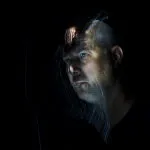
LICHTKUNSTFOTO
If you like my art visit www.lichtkunstfoto.de for more Light Art Photography and informations about Light Painting. Join me on Flickr Twitter



For more great Light Art Photography, Light Painting and inspiration check these light painters: @marlasinger666 @fadetoblack @fastchrisuk @dawnoner @oddballgraphics @martbarras @stepko @rod.evans.visual @yo-hoho @maxpateau @gunnarheilmann @neilru75 @maximepateau @ryuslightworks @lightstabeu @candelart @lacelight

WE ARE LIGHT PAINTERS

To help and support the LightPainters community here on Hive I would appreciate your delegation of HivePower. Any amount is appreciated. It does not require much to get started, we are happy for any gesture. @lightpainters
How to delegate?
Delegate 50HivePower, [50HP]
Delegate 250HivePower, [250HP]
Delegate 500HivePower, [500HP]
Delegate 1000HivePower, [1000HP]
All the Hive Power will help to upvote the artist's contribution as part of the LightPainters community.